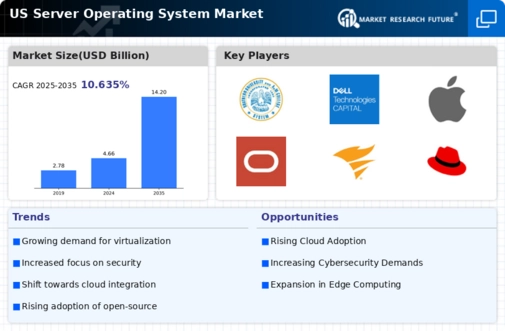Emergence of Edge Computing
The emergence of edge computing serves as a pivotal driver for the server operating-system market. As organizations increasingly deploy edge devices to process data closer to the source, there is a growing need for server operating systems that can support these decentralized architectures. The edge computing market is projected to grow at a CAGR of 30% through 2027, indicating a substantial opportunity for server operating systems tailored for edge environments. This trend suggests that server operating systems must evolve to accommodate the unique requirements of edge computing, such as low latency and real-time processing capabilities. As businesses seek to harness the benefits of edge computing, the server operating-system market is likely to witness significant innovation and adaptation.
Growing Cybersecurity Concerns
the server operating system market is driven by increasing cybersecurity concerns among organizations.. As cyber threats become more sophisticated, businesses are prioritizing the implementation of robust security measures within their server operating systems. Recent data indicates that cybercrime is projected to cost businesses over $10 trillion annually by 2025, highlighting the urgent need for enhanced security features. Consequently, server operating systems that offer advanced security protocols, such as encryption and intrusion detection, are in high demand. This trend reflects a broader shift towards prioritizing security in IT infrastructure, as organizations recognize that a secure server operating system is crucial for protecting sensitive data and maintaining operational integrity.
Regulatory Compliance and Standards
Regulatory compliance and standards represent a critical driver for the server operating-system market. Organizations are increasingly required to adhere to various regulations concerning data protection and privacy, such as the GDPR and HIPAA. This compliance necessitates the adoption of server operating systems that can ensure data integrity and security. Recent findings indicate that non-compliance can result in fines exceeding $20 million, emphasizing the financial implications of regulatory adherence. As a result, server operating systems that incorporate features designed to facilitate compliance are becoming essential for businesses. This trend highlights the intersection of regulatory requirements and technology, as organizations seek to align their server operating systems with legal standards while maintaining operational efficiency.
Rising Demand for Data Center Efficiency
The server operating-system market experiences a notable driver in the form of increasing demand for data center efficiency. Organizations are striving to optimize their IT infrastructure, leading to a shift towards more efficient server operating systems. According to recent data, the market for data center infrastructure is projected to grow at a CAGR of 10% through 2026. This growth is largely attributed to the need for reduced energy consumption and improved resource management. As companies seek to lower operational costs, the adoption of advanced server operating systems that enhance performance and scalability becomes essential. This trend indicates a strong correlation between data center efficiency and the evolution of the server operating-system market, as businesses prioritize systems that can support their growing data needs while minimizing environmental impact.
Increased Focus on Hybrid IT Environments
The server operating-system market is significantly influenced by the increasing focus on hybrid IT environments. Organizations are increasingly adopting a combination of on-premises and cloud-based solutions to enhance flexibility and scalability. This shift necessitates server operating systems that can seamlessly integrate with both environments. Recent statistics suggest that hybrid cloud adoption is expected to reach 70% by 2026, indicating a robust demand for compatible server operating systems. As businesses navigate this transition, the server operating-system market must adapt to provide solutions that facilitate smooth interoperability between diverse IT infrastructures. This trend underscores the importance of flexibility and adaptability in server operating systems, as organizations seek to leverage the benefits of both traditional and cloud-based resources.























Leave a Comment